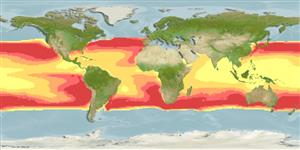Actinopterygii (strålfeniga fiskar) >
Perciformes (Perch-likes) >
Scombridae (Mackerels, tunas, bonitos) > Scombrinae
Etymology: Thunnus: Greek, thynnos = tunna (Ref. 45335).
Miljö / Klimat / Range
Ekologi
; marina; havsvandrande (Ref. 51243); djupintervall 0 - 250 m (Ref. 168), usually 0 - 50 m (Ref. 89423). Subtropical; 13°C - 29°C (Ref. 168), preferred 27°C (Ref. 107945); 45°N - 43°S, 180°W - 180°E
Atlantic, Indian and Pacific: in tropical and subtropical waters. Absent in the Mediterranean. Highly migratory species, Annex I of the 1982 Convention on the Law of the Sea (Ref. 26139).
Length at first maturity / Size / Vikt / Age
Maturity: Lm ?, range 100 - 125 cm
Max length : 250 cm TL hane/ej könsbestämd; (Ref. 27000); common length : 180 cm FL hane/ej könsbestämd; (Ref. 168); publicerad maxvikt: 210.0 kg (Ref. 9987); rapporterad maxålder: 11 år (Ref. 30326)
Taggstrålar i ryggfenan (totalt): 13 - 14; Mjukstrålar i ryggfenan (totalt): 14-15; Taggstrålar i analfenan 0; Mjukstrålar i analfenan: 14; Ryggkotor: 39. A large species, deepest near the middle of the first dorsal fin base. Lower sides and belly whitish; a lateral iridescent blue band runs along the sides in live specimens. The first dorsal fin is deep yellow, the second dorsal and anal fins are light yellow, the finlets are bright yellow edged with black.
Occur in areas where water temperatures range from 13°-29°C, but the optimum is between 17° and 22°C. Variation in occurrence is closely related to seasonal and climatic changes in surface temperature and thermocline. Juveniles and small adults school at the surface in mono-species groups or mixed with other tunas, may be associated with floating objects. Adults stay in deeper waters (Ref. 5377). Eggs and larvae are pelagic (Ref. 6390). Feed on a wide variety of fishes, cephalopods and crustaceans during the day and at night (Ref. 9340). Meat is highly prized and processed into sashimi in Japan. Marketed mainly canned or frozen (Ref. 9684), but also sold fresh (Ref. 9340).
Are multiple spawners that may spawn every 1 or 2 days over several months (Ref. 30330). They spawn over periods of the full moon (Ref. 6390). Spawn throughout the year in tropical waters (Ref. 6390).
Collette, B.B. and C.E. Nauen, 1983. FAO Species Catalogue. Vol. 2. Scombrids of the world. An annotated and illustrated catalogue of tunas, mackerels, bonitos and related species known to date. Rome: FAO. FAO Fish. Synop. 125(2):137 p. (Ref. 168)
IUCN Red List Status (Ref. 115185)
CITES (Ref. 94142)
Not Evaluated
Threat to humans
Harmless
Human uses
Fiskeri: kommersiellt viktig; sportfisk: ja
Verktyg
Special reports
Download XML
Internet-källor
Estimates of some properties based on models
Phylogenetic diversity index (Ref.
82805): PD
50 = 0.5039 [Uniqueness, from 0.5 = low to 2.0 = high].
Bayesian length-weight: a=0.01259 (0.00984 - 0.01610), b=3.03 (2.99 - 3.07), in cm Total Length, based on LWR estimates for this species (Ref.
93245).
Trofisk nivå (Ref.
69278): 4.5 ±0.0 se; Based on diet studies.
Resiliens (Ref.
69278): Mellan, lägsta populationsfördubblingstid 1,4-4,4 år (K=0.11-0.23; tm=3; tmax=11; Fec=2 million).
Prior r = 0.53, 2 SD range = 0.3 - 0.94, log(r) = -0.63, SD log(r) = 0.29, Based on: 1 M, 11 K, 2 tgen, 1 tmax, 4 Fec records
Vulnerability (Ref.
59153): High vulnerability (56 of 100) .
